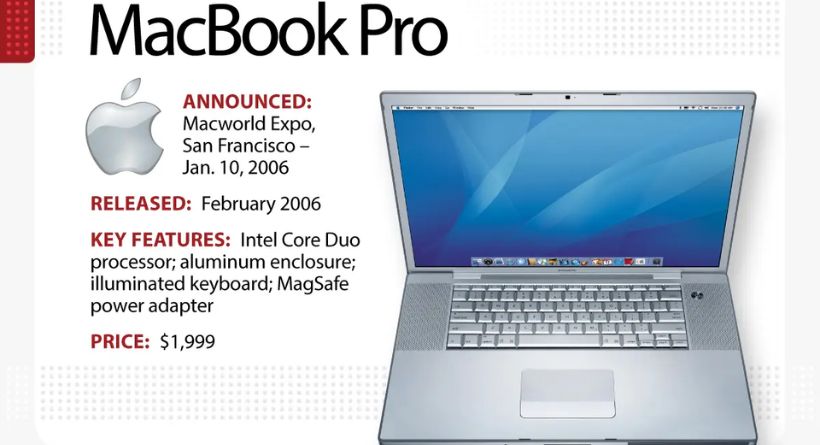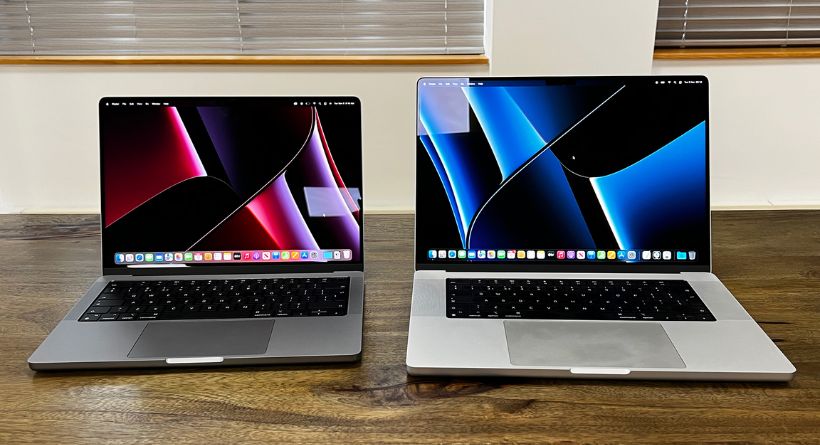The premium laptop from Apple is available with a 13- or 16-inch screen. Each model comes with 2-4 USB-C connections for peripherals, data transfer, and charging. The Touch Bar is also a feature of higher-end devices.
Since the start of the switch to Intel CPUs in early 2006, the high-end laptop from Apple has been referred to as the MacBook Pro. Now that Apple has switched to its silicon, the Pro moniker has persisted. Thanks to the ARM-based Apple chip, the most recent fourth and fifth-generation Pro Apple laptops offer significantly greater power with less heat generation and better battery life. For a synopsis of the present lineup and a brief history of the line, continue reading.
MacBook Pro history
The first-generation MacBook Pro was modeled after the PowerBook G4 but featured Intel processors instead of PowerPC chips.
With a unibody design, the second-generation MacBook Pro was the first to truly differentiate itself from earlier models. The retina display and MagSafe 2 were both first introduced in the third-generation MacBook Pro.
The fourth generation of the MacBook Pro is perhaps the most contentious model. While the loss of ethernet and the optical drive in the third generation caused considerable controversy, the device peripherals were completely rethought in the fourth generation. There were no longer any USB-A ports or MagSafes, and only the 13-inch model included the function keys. This updated MacBook Pro chose to just have a headphone jack and all Thunderbolt 3 connectors. An OLED Touch Bar was added to the MacBook Pro in place of the function keys. Apple redesigned the 13-inch MacBook Pro and unveiled the M1 processor in late 2020. The ARM-based CPU boosted performance while reducing power consumption.
Apple unveiled the fifth-generation MacBook Pro in October 2021, including not one, but two modernized M1 chips—the M1 Pro and M1 Max. With the removal of the Touch Bar and the addition of the HDMI Port, MagSafe charger, and SD card reader, numerous decisions made in the previous version were reversed.
Apple MacBook Pro 13-inch (M1, 2020)
Apple released the 13-inch M1 MacBook Pro as the most recent upgrade to the fourth-generation MacBook in late 2020. Although it has a similar appearance to earlier MacBook models, including the MacBook Air and Mac Mini, the MacBook now uses Apple silicon.
This was the first MacBook without an Intel CPU, and Apple’s M1 chip introduced ARM architecture to the MacBook range.
The 8-core CPU and 8-core CPU of the M1 chip are integrated onto one chip. The device’s unified memory is limited to either 8GB or 16GB due to the processor’s built-in memory. The 13-inch M1 MacBook Pro has a Magic Keyboard in place of the troublesome butterfly keyboard and can be customized with storage options ranging from 256GB to 2TB.
13-inch MacBook Pro pricing
The 13-inch M1 MacBook Pro costs $1,299 when new. This base setup costs $200 more if 16GB of RAM is added. The cost will increase by $200 for every 256GB, 512GB, 1TB, and 2TB increment of capacity. A 13-inch MacBook Pro with all the options will cost you $2,299.
On Apple’s website, you can customize your own 13-inch MacBook Pro.
Current 14-inch and 16-inch MacBook Pro
Apple introduced a whole new look for the MacBook Pro series in October 2021. Apple made the 13-inch screen a 14-inch and reduced the bezels on the 16-inch screen. Many issues with the previous generation were rectified in this fifth-generation laptop. MagSafe made a comeback as an upgraded MagSafe 3, and the MacBook also got an HDMI connector and an SD card slot back.
The Touch Bar is also gone. The typical row of function keys returns in its place. The most recent MacBooks also include a Promotion display with a variable refresh rate and a mini-LED backlight, which was originally seen on the iPad Pro.
While the display has been enlarged, the 2021 MacBooks also have a huge notch for the 1080P FaceTime camera, which has drawn criticism. There are various reasons why Face ID is not entirely feasible, even though it would have been a wonderful feature in exchange for this little portion of the screen.
14-inch MacBook Pro pricing
The price of the 14-inch MacBook Pro is $1,999. The M1 Pro processor, which has an 8-core CPU and 14-core GPU, and 16GB and 512GB of storage are all included in the basic model. The M1 Pro CPU comes in a variety of variants, however upgrading to an M1 Max processor will cost you $500 more and need a $400 memory increase to 32GB. You may set up to the full 64GB of RAM, an $800 premium if you choose the M1 Max CPU.
The 2021 14-inch MacBook Pro comes with up to 8TB of storage configuration options. Costs for upgrades are as follows:
- $200 for 1TB of SSD storage
- $600 for 2TB of SSD storage
- $1,200 for 4TB of SSD storage
- $2,400 for 8TB of SSD storage
On Apple’s website, you can personalize your own 14-inch MacBook Pro.
16-inch MacBook Pro pricing
The entry-level 16-inch MacBook Pro costs $2,499. There is just one M1 Pro processor available for the 16-inch MacBook, and it is the most advanced model with a 10-core CPU and 16-core GPU, which costs $300 more than the 14-inch MacBook Pro. Of course, you can upgrade to the M1 Max CPU for $200 or $400, depending on whether it has a 24-core or 32-core GPU (which also needs the $400 increase to 32GB of RAM). The 14-inch MacBook Pro’s RAM and storage choices are the same.
On Apple’s website, you can customize a 16-inch MacBook Pro to your liking.


